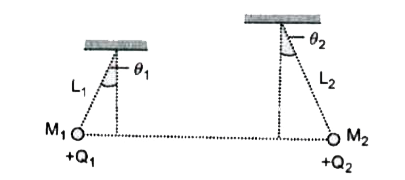Radiation of wavelength 180 nm eject photoelectrons from a plate whose work function is 2.0 eV. If a uniform magnetic field of flux density 5.0×10−5T is applied parallel to plate, what should be the radius of the path followed by electrons ejected normally from the plate with maximum energy: Solution in Kannada
0.074 m
0.592m
0.419m
0.149
The correct Answer is:D
E−hv−w=hcλ−w
Here λ=nm=180×10−19m
w=2⋅0eV=2⋅0×1⋅6×10−9J
∴E=7⋅8×10−19J
Also 12mv2=E∴V=√2Em
So v=√2×7⋅8×10−199⋅1×10−31=1⋅31×106m/s
Radius r in a magnetic field of induction B is given by
Bev=mv2rorr=mveB
Using B=5×10−5T
Then r=0⋅149m
Topper's Solved these Questions
- ELECTRONS & PHOTONSBOOK - MODERN PUBLICATIONCHAPTER - ELECTRONS & PHOTONSEXERCISE - MULTIPLE CHOICE QUESTIONS (LEVEL-III)
9 Videos
- ELECTRONS & PHOTONSBOOK - MODERN PUBLICATIONCHAPTER - ELECTRONS & PHOTONSEXERCISE - RECENT COMPETITIVE QUESTIONS
20 Videos
- ELECTRONS & PHOTONSBOOK - MODERN PUBLICATIONCHAPTER - ELECTRONS & PHOTONSEXERCISE - RECENT COMPETITIVE QUESTIONS
20 Videos
- ELECTROMAGNETIC WAVESBOOK - MODERN PUBLICATIONCHAPTER - ELECTROMAGNETIC WAVESEXERCISE - RECENT COMPETITIVE QUESTIONS
4 Videos
- ELECTROSTATICSBOOK - MODERN PUBLICATIONCHAPTER - ELECTROSTATICSEXERCISE - RECENT COMPETITIVE QUESTIONS
39 Videos
Similar Questions
Energy required for the electron excitation in Li++ from the first to the third Bohr orbit is :
View SolutionAccording to Einstein's photoelectric equation the graph of K.E. of the photoelectron emitted from the metal versus the frequency of the incident radiation gives a straight line graph whose slope
View SolutionAccording to Einstein's photoelectric equation the graph of K.E. of the photoelectron emitted from the metal versus the frequency of the incident radiation gives a straight line graph whose slope
View SolutionThe speed of electromagnetic wave in vacuum depends upon the source of radiation
View SolutionTwo small spheres of masses M1andM2 are suspended by weightless insulating threads of lengths L1andL2 The spheres carry charges Q1andq2 respectively . The spheres are suspended such that they are in level with one another and the threads are inclined to the vertical at angles of θ1andθ2 as shown . Which one o fthe following conditions , if θ1=θ2 ?

View SolutionLight of wavelength 180 nm ejects photoelectrons from a plate of metal whose work - function is 2 eV. If a uniform magnetic field of 5xx10^(-5) T be applied parllel to the palte, what would be the radius of the path followed by electrons ejected normally from the plate with maximum energy.
View SolutionThe energy required to stop ejection of electrons from a Cu plate is 0.24 eV .Calculate the work function Cu when a radiation of wavelength lambda = 250 nm strikes the plate
View SolutionWhen photons of energy hv fall on an aluminium plate (of work function E0), photoelectrons of maximum kinetic energy K are ejected . If the frequency of the radiation is doubled , the maximum kinetic energy of the ejected photoelectrons will be
View SolutionRadiation of a certain wavelength causes electrons with a maximum kinetic energy of 0.65 eV to be ejected from a metal surface whose work function is 2.65 eV. What will be the maximum kinetic energy (in eV) with which this same radiation ejects electrons from another metal whose work function is 2.15eV.
View SolutionWhen photons of energy hv fall on a metal plate of work function 'W0' , photoelectrons of maximum kinetic energy 'K' are ejected. If the frequency of the radiation is doubted, the maximum kinetic energy of the ejected photoelectrons will be
View SolutionCalcium plate has maximum possible radiation of wavelength 1 of 400 nm to eject electrons . It’s work function is
View SolutionRadiation of wavelength 120 nm ejects photoelectrons from a plate whose work function is 3.0 eV. If a magnetic field of flux density 4.0×10−5 T is applied parallel to the plate, then the radius of the path followed by electrons ejected normally from the plate with maximum energy will be
View SolutionLight of wavelength 1800 Å ejects photoelectrons from a plate of a metal whose work functions is 2 eV. If a uniform magnetic field of 5×10−5 tesla is applied parallel to plate, what would be the radius of the path followed by electrons ejected normally from the plate with maximum energy.
View SolutionRadiation of wavelength 180 nm eject photoelectrons from a plate whose work function is 2.0 eV. If a uniform magnetic field of flux density 5.0xx10^(-5)T is applied parallel to plate, what should be the radius of the path followed by electrons ejected normally from the plate with maximum energy:
View SolutionEnergy required to stop the ejection of electrons from Cu-plate 0.27 eV. Calculate the work function (in eV) When radiation of lambda = 235nm strikes the plate.
View Solution
